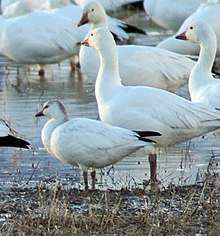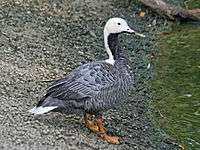Chen (genus)
The white geese are a small group of waterfowl which are united in the genus or subgenus Chen, in the true geese and swan subfamily Anserinae. They breed on subarctic areas of North America and around the Bering Strait, migrating south in winter.
| White geese | |
|---|---|
 | |
| Immature Ross's goose (Chen rossii, left) and adult lesser snow geese (C. caerulescens caerulescens) | |
| Scientific classification | |
| Kingdom: | Animalia |
| Phylum: | Chordata |
| Class: | Aves |
| Order: | Anseriformes |
| Family: | Anatidae |
| Subfamily: | Anserinae |
| Genus: | Chen Boie, 1822 |
| Species | |
|
see text. | |
| Synonyms | |
|
Philacte Bannister, 1870 | |
Most authorities now place these species in the grey goose genus Anser. Indeed, Chen and Anser are anatomically indistinguishable. However, external morphology, biogeography, and molecular data suggest that the white geese are indeed an evolutionary lineage distinct from the grey geese—from which they split off fairly recently, essentially replacing them in North America. The AOU recognizes this genus as distinct; most other authorities today consider it a subgenus of Anser.
Like grey but unlike the Branta black geese, their feet and legs are colored in reddish hues. The bill is also reddish in these birds as in most grey geese, except in adult males of Ross's goose which have a blue-black grainy cere. The wingtips are black, as in all true geese, whereas the head is always white without any markings or pattern in adult birds of this genus, which distinguishes them from all other true geese except feral domesticated geese. The rest of the plumage is either white all over, or colored in various dark bluish-grey hues; the latter birds, uniquely among true geese, do not have white uppertail and undertail coverts, though the tail itself may be white.
White-phase snow geese of both species can be told apart from feral geese best by the more slender, elegant neck, which is thick-set in domestic geese; these also have a generally heavier body and often lack black wingtips.
Species
| Image | Scientific name | Common Name | Distribution |
|---|---|---|---|
| Chen caerulescens | Snow goose | Greenland, Canada, Alaska, and the northeastern tip of Siberia, and spends winters in warm parts of North America from southwestern British Columbia through parts of the United States to Mexico | |
_(23108182770).jpg) | Chen rossii | Ross's goose | northern Canada, south in the continent in the southern United States and occasionally northern Mexico. |
 | Chen canagica | Emperor goose | Alaska, United States, but also in Kamchatka, Russia |
The supposed fossil dwarf snow goose Chen pressa is now placed in Anser (Brodkorb, 1964).
References
- Brodkorb, Pierce (1964). "Catalogue of Fossil Birds: Part 2 (Anseriformes through Galliformes)" (PDF). Bulletin of the Florida State Museum. University of Florida. 8 (3): 195–335. Archived (PDF) from the original on September 5, 2018.
- Carboneras, Carles (1992). "Family Anatidae (Ducks, Geese and Swans)". In Hoyo, Josep; Elliott, Andrew; Sargatal, Jordi (eds.). Handbook of Birds of the World, Volume 1: Ostrich to Ducks. Barcelona: Lynx Edicions. pp. 536–629. ISBN 84-87334-10-5.